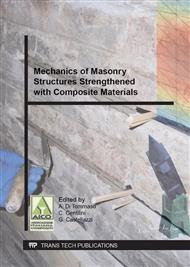p.88
p.97
p.106
p.114
p.123
p.131
p.139
p.147
p.155
Finite Element Modelling of Acoustic Waves Propagation in Stone Masonry
Abstract:
Abstract. The paper deals with the finite element modelling of acoustic waves propagation through a stone masonry specimen. In the last decades major efforts have been devoted to improve Sonic and Ultrasonic analysis of structural members and provide suitable correlations between acoustic wave features and the material parameters. This paper concerns the ultrasonic analysis and tomography of a masonry specimen made of trachyte blocks and cement mortar, including an inner void as an anomaly supposed to be detected by the analysis. The tests were performed with several equipments accordingly to the Direct Transmission Technique, transmitting an ultrasound signal by a piezoelectric transducer and detecting and analysing the signal received on the opposite side by another transducer. Basically the transmission time of the signal through an ideal path from the emitting and receiving transducers and the resulting wave speed are regarded as the main phenomenological measurements for non-homogeneity and anomalies detection.
Info:
Periodical:
Pages:
123-130
Citation:
Online since:
September 2014
Authors:
Price:
Сopyright:
© 2015 Trans Tech Publications Ltd. All Rights Reserved
Share:
Citation:


